Japan
Wood Products Prices
Dollar Exchange Rates of 10th
October
2018
Japan Yen 112.16
Reports From Japan
¡¡
Optimism detected in consumer
sentiment survey
Japan's September consumer confidence index was
slightly up from a month earlier according to the Cabinet
Office in Japan.
Of the individual components used to compile to overall
index that for income growth prospects rose, not surprising
given the tight labour market in Japan. The slightly more
optimistic tone of the survey results was also reflected in a
rise in the index on prospects for expenditure on durable
goods.
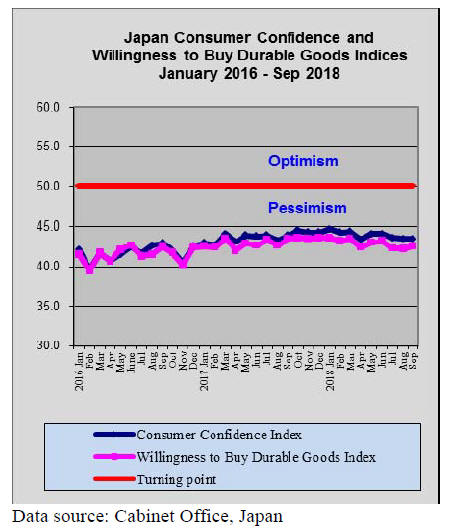
IMF calls for fresh look at economic
challenges in
Japan
Christine Lagarde, Head of the IMF, was recently in Japan
where she called for an overhaul of Japan's economic
policy (so-called ¡®Abenomics¡¯) to tackle stubbornly low
inflation and sluggish growth.
She warned that ¡°the economic challenges facing Japan
will only grow as Japan's population continues to age and
shrink," noting that both the size of the economy and the
population would contract by a quarter over the next 40
years.
The report from the IMF says ¡°Six years into
¡®Abenomics¡¯, notwithstanding considerable
accomplishments, a fresh look at remaining challenges is
warranted. On the positive side, unemployment rate is at a
25 year low and the fiscal deficit has been halved,
employment and female labor force participation have
increased substantially, deflationary risks have been
reduced and corporate cash reserves are at all-time highs.
However, inflation remains well below BoJ¡¯s target, fiscal
policies have yet to put public debt on a sustainable path,
and household incomes remain stagnant.
Demographic change will depress growth and productivity
due to a shrinking and ageing labor force and a shift
toward consumption, while fiscal challenges will magnify
with rising age-related government spending and a
shrinking tax base.
Additionally, labor market rigidities limit productivity
growth and hamper the pass-through of demand stimulus
to real wages and prices¡ªeffectively undercutting
monetary transmission and blunting the impact of fiscal
support.¡±
Multiple natural disasters drive down business
sentiment
A string of natural disasters seriously disrupted industrial
production and drove down business confidence among
Japan¡¯s big manufacturers as reflected in the latest Bank of
Japan (BoJ) quarterly review. In fact, business confidence
dropped to its lowest in more than a year.
The prospect of escalations in the trade friction between
the US and China dampened businesses capital
expenditure plans.
The overall impression from the latest business survey is
at odds with the rosy picture of economic prospects from
the BoJ.
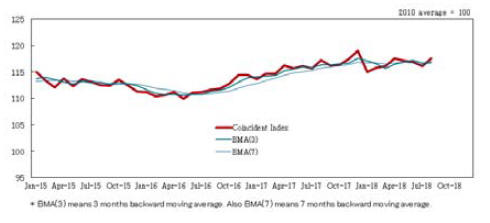
Stock market dip drives down dollar ¨C yen
gains
The US dollar struggled to maintain its recent gains as a
result of the mid-month decline in US and global stock
values. Looking forward, weaker than expected US
consumer price movement in September has driven fears
that the Federal Reserve may skip an interest rate hike at
its next review which would further dampen interest in US
dollar holdings.
In the face of uncertainty the yen once again became the
favorite and over the past two weeks has been showing
some gains against the US dollar.
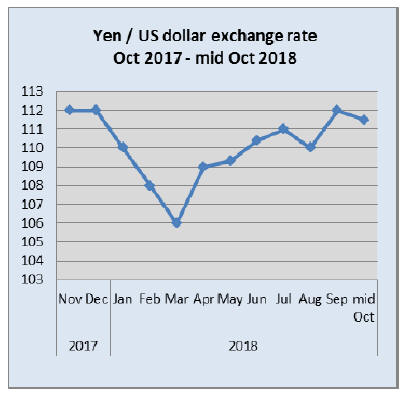
Prefab home production represents new market
opportunity
In Japan, around 15%, approx. 10,000 units of new homes
are prefabricated by the top three house builders which
specialise in producing factory-perfect home components.
The prefabricated housing technology developed in Japan
is opening up new opportunities for house builders in
export markets.
A recent article Preparing for our prefab future: A
burgeoning US prefab market has much to learn from
Japan¡± highlights the advances of Japanese factory-built
houses.
See: https://www.curbed.com/2017/10/25/16534122/prefabhomes-
manufacturing-japan-vs-us
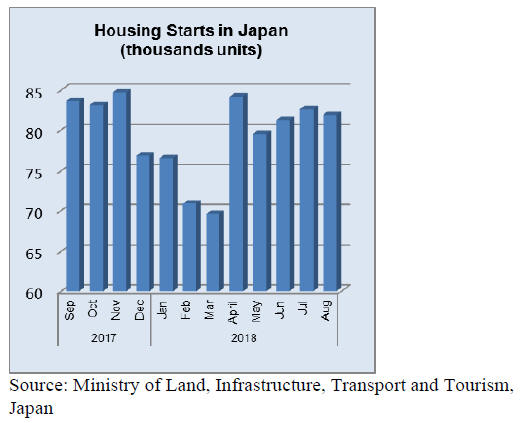
Wooden furniture imports
The combined value of Japan¡¯s wooden office, kitchen and
bedroom furniture imports between January and July this
year was the lowest for the year mirroring the pattern seen
in 2017. This largely reflects importers adjustment of
shipments to take account of the holiday period when
furniture sales are traditionally quiet.
Compared to the month earlier, July imports of wooden
office, kitchen and bedroom furniture were down around
6%. If imports follow the pattern in previous years there
should be a pick-up in the value of furniture imports
beginning in September.
Of the three categories of wooden furniture tracked the
sharpest decline in July was in office furniture, there was a
slight drop in the value of wooden bedroom furniture but
imports of kitchen furniture held up well.

Office furniture imports (HS 940330)
Year on year, the value of Japan¡¯s July 2018 imports of
wooden office furniture (HS940330) fell over 40%, the
lowest level for the year to July.
In contrast, month on month imports were down just 28%.
Shippers in China and Portugal saw a 30% decline in
orders from Japan in July.
The top three shippers of wooden office furniture to Japan
in July were China, Germany and Portugal. These three
accounted for over 70% of all Japan¡¯s imports of wooden
office furniture.

Kitchen furniture imports (HS 940340)
The value of Japan¡¯s kitchen furniture imports have
moved up and down in a very narrow range this year. Year
on year imports of wooden kitchen furniture were 23%
higher in July 2018 but month on month they dropped 7%
with most of this decline being borne by shippers in China.
As has been the case since the beginning of 2018, three
suppliers accounted for most of Japan¡¯s wooden kitchen
furniture imports; the Philippines, (52% up slightly month
on month), Vietnam (36%, unchanged month on month)
and China (7% down slightly month on month).
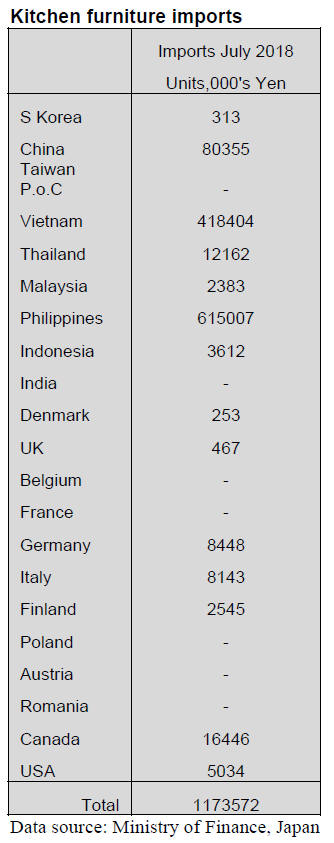
Bedroom furniture imports (HS 940350)
July marked the second consecutive month on month
decline in the value of Japan¡¯s wooden bedroom furniture
imports. However, year on year the value of imports was
largely unchanged.
China retained its position as the number one shipper of
wooden bedroom furniture to Japan, accounting for over
half of all imports of this category of furniture.
Vietnam also retained its second ranked position
accounting for an additional 30% of all of Japan¡¯s wooden
bedroom furniture imports. Interestingly, July shipments
from Vietnam were up 12% as it seems shippers in
Vietnam are capturing market share from exporters in
Thailand.

Trade news from the Japan Lumber Reports (JLR)
For the JLR report please see:
http://www.nmokuzai.
com/modules/general/index.php?id=7
South Sea (tropical) log imports for the first half 2018
Total South Sea log import for the first half of this year
was 80,657 cbms, 31.1% more than 2017.
Since Sabah, Malaysia stopped log export, log import for
the second half would decrease considerably.
In 2017, Sarawak, Malaysia tightened log harvest and
timber premium was raised the India purchased large
volume before GTS tax was raised so log FOB prices
soared then India¡¯s purchase slowed down in fall 2017 at
which time, Japan purchased larger volume, which arrived
Japan in early 2018. This pushed the volume for the first
half.
Sabah¡¯s log export ban started in May this year. Japan
relied on Sabah logs recently.
Actually over 10,000 cbms of Sabah logs were imported in
January, February and May and total of Sabah logs were
30% more than 2017. The importers are looking for
substituting sources and only source seems to be PNG.
Without Sabah logs, log buyers go to Sarawak.
Meranti regular log prices in Sarawak had been about
US$300 per cbm FOB but now the prices climbed to
US$320. Log prices in PNG are leveling off after China,
the main PNG log buyer, slowed down after general
economy peaked off.
Japanese plywood mills carry ample log inventories now
with large arrivals in the first half. In any case, price hike
of wood products of South Sea logs.
South Sea (tropical) logs and lumber
After Sabah, Malaysia banned log export in last May, log
purchase shifted to PNG. There have been no logs from
Sabah since June.
Logs from Sarawak, Malaysia continue coming in but the
volume is limited by harvest restriction by environmental
reasons and increased duty. Meranti regular log prices in
Sarawak are minimum of US$320 per cbm FOB, sizable
increase after Sabah logs became unavailable. Some
buyers procure small MLH in Sarawak.
Prices of mersawa from PNG shot up temporarily but
leveled off after China slowed down the purchase. The
prices are higher than meranti but the Japanese plywood
mills intend to continue buying mersawa steadily.
Keruing for lumber is short with very little log supply. The
buyers in Japan keep buying lumber from South East
Asian countries but the supply is unstable.
Price of Vietnamese eucalyptus plywood for crating is
edging up by higher production cost and increasing
plywood production facilities by China.
Plywood conference by three countries
Plywood conference by three countries of Indonesia,
Malaysia and Japan was held in Tokyo in September.
At the meeting, each country explained situation of
plywood industry, raw material problem and trend of
trade.
Japan explained that majority of raw material of plywood
is now domestic wood and 52 % of plywood supply is
domestic but 48% is imports, which is indispensable
materials for such items like floor base and concrete
forming panel.
Domestic manufacturers mainly produce structural panel
but they are now trying to produce non-structural products
like floor base and concrete forming panel with softwood
but the volume is limited and it is far from replacing
imports.
Both in Indonesia and Malaysia, use of planted trees has
been increasing. In Sarawak, Malaysia forecast of natural
grown timber harvest is 4.4-4.5 million cbms, 1.0 million
cbms less than 2017 while plantation wood will be 1.6-1.8
million cbms, 200,000 cbms more than 2017. Therefore,
manufacturing of plantation wood is key to the future.
In Indonesia, it is suffering duty sanction by the U.S.A. for
plywood export. U.S.A. is the second largest market next
to Japan but the future is unpredictable. China is the
biggest target of U.S.A. trade sanctions so exporting
plywood from China to U.S.A is becoming difficult so
China is now shifting producing facilities to Indonesia and
export plywood to the U.S.A through third country like
Vietnam.
Wood pellet supply
The Forestry Agency announced wood pellet supply in
2017. Domestic production was 126,532 tonne, 5.3% more
than 2016.
Import of wood pellet increased considerably to 506,353
tonne, 46% more. Domestic share is now down to 20%
while imports is up to 80%.
Reason of supply increase is demand of fuel increased.
Total wood pellet supply in 2017 was 632,885 tonne,
35.5% more than 2016. In 2013, total was about 190,000
tonne and share of imports was 43% then the imports
exceeded in 2015 and the share rose to 80% in 2017.
Sources of imports are mainly Canada and Vietnam.
Others like Southern U.S.A., Malaysia, Thailand and
Russia will increase the supply for Japan.
Domestic supply has increased for three straight years.
Fuel use was 122,047 tonne, 7.4% more than 2016. Use
for heating like wood stove was not main reason of
increase. Combination use with coal for power generation
increased, which uses mainly imported wood pellet.
Number of wood pellet manufacturers in Japan is 147, one
less than 2016. Raw materials are 45% of sawmills¡¯
residue of 56,920 tonne then 45,926 ton of logs and
leftover fiber in the woods and 21,657 tonne of building
scraps.
Import wood pellet prices
Wood pellet prices in Vietnam, one of main wood pellet
supplying countries, soared since September last year by
bullish purchase by Korea and the prices in this summer
are US$145-148 per tonne FOB, US$40 up from
September last year then Korean purchase slowed down
by excessive inventories and the prices turned softer and
the prices in early this month are down to less than
US$140. Present market continues weak with the prices
being US$135 and forecast is the prices would soon drop
less than $130.
PKS prices are holding at about US$80 per tonne FOB.
Indonesian PKS prices are US$108 per ton C&F. The
prices vary by degree of removal of debris. Then there is
difference of ocean freight by loading location.
PKS supply is ample and buyers¡¯ market pushed the
export prices down but now the supply and demand are
balancing so the export prices should be bottoming.
Wood biomass used for energy
The Forestry Agency disclosed wood biomass used for
energy. In 2017, wood chip used for energy such as
biomass power generation was about 8,370,080 BD tonne,
12.8% more than 2016. It has been increasing steadily for
last three years.
This proves that there are increasing numbers of biomass
power generation facilities under FIT system. This
investigation is based on owners of boiler or power
generation, which use biomass fuel such as biomass power
generation facilities, power generation facilities, which use
biomass fuel combined with coal, boiler to generate heat.
The Agency investigated amount of biomass. In total of
1,447, 1,398 companies responded.
Wood chip made from thinning and leftover fiber in the
woods increased by about 40%. Imported wood chip
increased by 15 times although absolute volume is small
yet.
Wood chip derived from sawmill residue decreased to
1,500,000 BD tonne, about 150,000 tonne less than 2016
while wood chip from building scrap increased by about
150,000 BD ton. Low price of wood chip made from
building scrap replaced wood chip by sawmill residue.
Total wood chip volume was 12.8% more than 2016 or
one million BD ton. Main reason is increased number of
FIT biomass power generation facilities and increased use
of wood chip by coal burning power generation facilities.
By statistics the Agency for natural resources and energy
made, new FIT power generation stations, which use
biomass fuel and started the operation in 2017 was 25 with
total output of 329,368 kw. Not only large power stations,
there are increasing number of small biomass power
stations and localized heat stations.
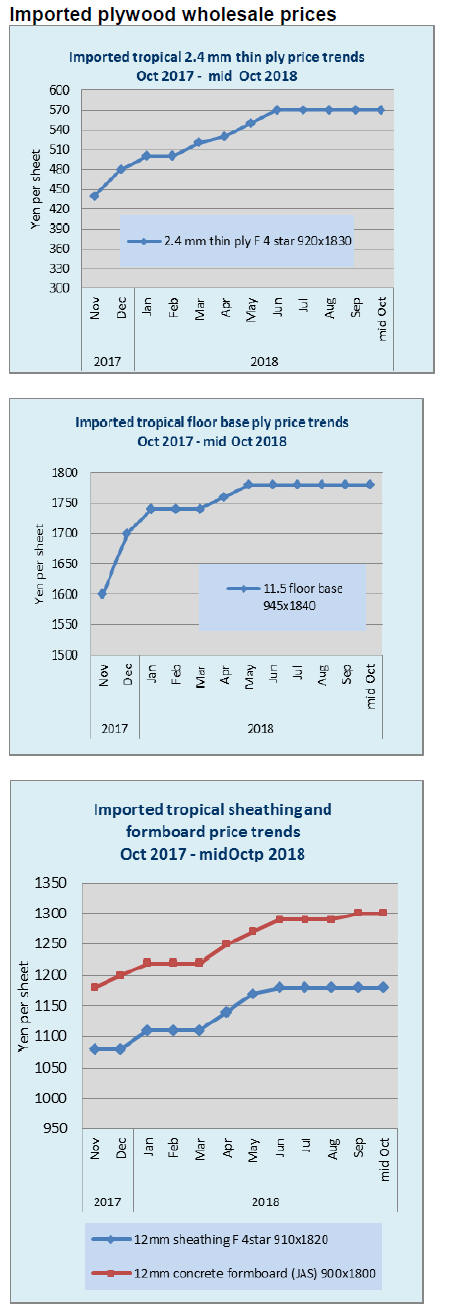
|